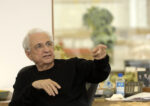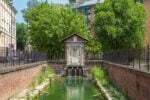Thomas Ruff

Sesta mostra personale di Thomas Ruff con la galleria, a suggello di una lunga e fortunata collaborazione iniziata nel 1991 con una mostra nella sede di Napoli.
Comunicato stampa
Sabato 15 novembre 2025 la Galleria Lia Rumma inaugura a Milano la sesta mostra personale di Thomas Ruff con la galleria, a suggello di una lunga e fortunata collaborazione iniziata nel 1991 con una mostra nella sede di Napoli. Nella sua pratica ultraquarantennale Ruff ha esplorato senza sosta i limiti e la struttura del medium fotografico, dando vita a un corpus organizzato in diverse tipologie di lavori che hanno messo profondamente in questione il nostro modo di guardare alle immagini e hanno contribuito a ridefinire la natura stessa di ciò che chiamiamo fotografia.
La mostra si articola sui tre piani della galleria e mette a confronto opere appartenenti a sette serie sviluppate dall’artista negli ultimi 25 anni utilizzando tecniche diverse, dai nudes di fine anni ’90 che attingono al vasto serbatoio delle immagini trovate online, fino ai recenti untitled# (2022) e alle expériences lumineuses del 2024, realizzati da Ruff nel suo studio utilizzando una delle sue macchine fotografiche. È da questi due cicli più recenti che prende avvio il percorso espositivo al piano terra, con cinque opere esposte per ciascuna serie. Gli untitled# sono fotografie astratte ispirate a esperienze pionieristiche quali i Metaforms di Etienne Bertrand Weill e i Rythmograms creati da Peter Keetman e Heinrich Heidersberger negli anni ’50 e ’60. Ruff fa uso di lunghe esposizioni per catturare il movimento rotatorio di un corpo luminoso, in questo caso una bobina di filo d’argento, soffermandosi sulle tracce che ne risultano: linee, forme astratte, strutture grafiche. Come per gli untitled#, la luce è il soggetto principale delle expériences lumineuses, realizzate in studio mettendo in atto un semplice esperimento fisico che aiuta a visualizzare lo spettro elettromagnetico. L’artista fotografa le riflessioni e rifrazioni di alcuni fasci luminosi che attraversano oggetti in vetro quali lenti, specchi e prismi, poi inverte digitalmente l’immagine prima di stamparla su tela, ottenendo un effetto vicino all’astrazione pittorica a partire dalla documentazione di un fenomeno scientifico.
La mostra prosegue al primo piano con lavori che esplorano il potenziale estetico di formule matematiche e sondano la loro capacità di generare immagini. Gli arazzi della serie d.o.pe, il cui titolo fa riferimento al saggio autobiografico “The Doors of Perception” (Le Porte della Percezione) di Aldous Huxley, sono realizzati sovrapponendo porzioni ingrandite del frattale di Mandelbrot, un insieme di numeri complessi definito da alcuni studiosi “l’oggetto geometrico più complesso esistente in matematica”. Il risultato di questa operazione sono opere tessili psichedeliche dal forte impatto visivo che a prima vista potrebbero sembrare immagini del mondo naturale, mentre sono totalmente artificiali. È forte qui il richiamo all’immaginario lisergico degli anni ’60 e ’70 – che si tratti di copertine di gruppi musicali quali Grateful Dead, King Crimson, Pink Floyd o Jefferson Airplane o di film come “Odissea nello Spazio” di Stanley Kubrick - senza dimenticare i mondi fantastici dipinti da pittori rinascimentali quali Bosch e Grünewald.
Nella stessa stanza, le opere fotografiche della serie zycles condividono l’origine matematica, ma a differenza dei d.o.pe prendono ispirazione da illustrazioni ottocentesche di campi elettromagnetici. Partendo da algoritmi e utilizzando un programma di modellazione 3D, Ruff crea composizioni virtuali dinamiche le cui linee evocano orbite planetarie e disegni minimalisti.
A completare il percorso al secondo piano alcune opere dalle serie photograms - fotogrammi digitali anch’essi costruiti con l’ausilio di un software 3D - e press ++, in cui le informazioni tecniche e di contesto annotate sul retro delle fotografie vengono trasferite sul fronte e sovrapposte alle immagini di riferimento. In mostra anche una fotografia dalla celebre serie nudes, realizzata a partire da immagini di corpi nudi trovate sul web e ingrandite fino a sfocarle, per dare risalto al loro valore estetico piuttosto che alla natura esplicita della fonte.
Thomas Ruff (n. 1958) ha raggiunto il riconoscimento internazionale alla fine degli anni Ottanta come figura di punta della Scuola di Düsseldorf, gruppo di fotografi formatisi sotto la guida di Bernd e Hilla Becher, noti per aver ridefinito le possibilità della fotografia attraverso un approccio concettuale e sperimentale. Ruff si è presto distinto per una radicale deviazione dallo stile documentario dei suoi maestri, sviluppando un linguaggio autonomo volto a indagare la struttura e la grammatica stessa della fotografia. Attraverso strategie come la manipolazione digitale e manuale dell’immagine, l’uso del grande formato e l’appropriazione di immagini trovate, Ruff ha esplorato in modo sistematico diversi generi – dal ritratto al nudo, dal paesaggio alla fotografia architettonica. Lavorando per serie distinte, l'artista analizza come il significato fotografico venga modellato dalla tecnologia e dalla percezione. La sua continua ricerca su quella che definisce la “grammatica della fotografia” lo ha reso uno degli artisti più influenti della sua generazione, ispirando nuove generazioni di fotografi e ampliando i confini concettuali del mezzo. Tra le mostre personali più recenti si ricordano: Malkastenforum di Düsseldorf (2024); MAMC+, Saint-Étienne (2022); National Taiwan Museum of Fine Arts, Taichung (2021). Altre importanti esposizioni sono state ospitate da K20 – Kunstsammlung Nordrhein-Westfalen, Düsseldorf (2020–21); Whitechapel Gallery, Londra (2017); The National Museum of Modern Art, Tokyo (2016); Art Gallery of Ontario, Toronto (2016); Haus der Kunst, Monaco (2012) e Castello di Rivoli, Torino (2009). Le opere di Thomas Ruff fanno parte delle collezioni dei più importanti musei del mondo, tra cui il Metropolitan Museum of Art e il Solomon R. Guggenheim Museum di New York, l’Art Institute of Chicago, la Nationalgalerie di Berlino e il Moderna Museet di Stoccolma. Vive e lavora a Düsseldorf.
On Saturday, 15 November 2025, Lia Rumma Gallery opens in Milan Thomas Ruff’s sixth solo exhibition with the gallery, marking a long and fruitful collaboration that began in 1991 with a show at the Naples venue. Throughout his over forty-year practice, Ruff has ceaselessly explored the limits and structure of the photographic medium, developing a corpus organized into various typologies of works that have profoundly questioned our way of looking at images and have helped to redefine the very nature of what we call photography.
The exhibition unfolds across the gallery’s three floors and brings together works from seven series developed by the artist over the past 25 years using different techniques—from the nudes of the late 1990s, which draw from the vast reservoir of images found online, to the recent untitled# (2022) and expériences lumineuses (2024), created by Ruff in his studio using one of his cameras.
The exhibition begins on the ground floor with five works from each of these two most recent series. The untitled# are abstract photographs inspired by pioneering experiments such as Etienne Bertrand Weill’s Metaforms and the Rythmograms created by Peter Keetman and Heinrich Heidersberger in the 1950s and 1960s. Ruff uses long exposures to capture the rotational movement of a luminous body—in this case, a spool of silver thread— focusing on the resulting traces: lines, abstract forms, graphic structures. As with the untitled#, light is also the main subject of the expériences lumineuses, realized in the studio through a simple physical experiment that helps visualize the electromagnetic spectrum. The artist photographs the reflections and refractions of light beams passing through glass objects such as lenses, mirrors, and prisms, then digitally inverts the image before printing it on canvas, thus achieving an effect close to painterly abstraction derived from the documentation of a scientific phenomenon.
The exhibition continues on the first floor with works that explore the aesthetic potential of mathematical formulas and their capacity to generate images. The tapestries from the d.o.pe series—whose title refers to Aldous Huxley’s autobiographical essay “The Doors of Perception”—are made by superimposing enlarged portions of the Mandelbrot fractal, a set of complex numbers described by some scholars as “the most complex geometric object in mathematics.” The result is a group of psychedelic textile works of strong visual impact that might at first glance appear to depict scenes from the natural world, though they are entirely artificial.
Here the reference to the hallucinatory imagery of the 1960s and ’70s is striking—whether in the album covers of bands such as the Grateful Dead, King Crimson, Pink Floyd, or Jefferson Airplane, or in films like Stanley Kubrick’s 2001: A Space Odyssey—as well as to the fantastic worlds painted by Renaissance artists such as Bosch and Grünewald. In the same room, the photographic works from the zycles series share a mathematical origin, though unlike the d.o.pe, they take inspiration from nineteenth-century illustrations of electromagnetic fields. Starting from algorithms and using 3D modeling software, Ruff creates dynamic virtual compositions whose lines evoke planetary orbits and minimalist drawings.
Completing the exhibition on the second floor are works from the photograms series—digital photograms also constructed with the aid of 3D software—and from the press++ series, in which the technical and contextual information annotated on the back of press photographs is transferred to the front and overlaid onto the corresponding image. The exhibition also includes a photograph from the celebrated nudes series, created from images of naked bodies found online and enlarged to the point of blurring, in order to emphasize their aesthetic value rather than the explicit nature of their source.
Thomas Ruff (b. 1958) first gained international recognition in the late 1980s as a leading figure of the Düsseldorf School, a group of photographers trained under Bernd and Hilla Becher who redefined the possibilities of photography through a conceptual and experimental approach. Ruff soon distinguished himself by radically departing from the Bechers’ documentary style, developing a body of work that investigates the very structure and language of photography. Using strategies such as digital and manual image manipulation, large-scale printing, and the appropriation of found images, he has systematically explored genres including portraiture, the nude, landscape, and architectural photography. Working in distinct series, Ruff examines how photographic meaning is shaped by technology and perception. His sustained inquiry into what he calls the “grammar of photography” has made him one of the most influential artists of his generation, inspiring younger photographers and expanding the medium’s conceptual reach. Recent solo exhibitions include: Malkastenforum, Düsseldorf (2024); MAMC+, Saint-Étienne (2022); National Taiwan Museum of Fine Arts, Taichung (2021). Other major presentations have been held at K20 – Kunstsammlung Nordrhein-Westfalen, Düsseldorf (2020–21); Whitechapel Gallery, London (2017); The National Museum of Modern Art, Tokyo (2016); Art Gallery of Ontario, Toronto (2016); Haus der Kunst, Munich (2012) and Castello di Rivoli, Turin (2009). Thomas Ruff’s works are part of major museum collections worldwide, including The Metropolitan Museum of Art and the Solomon R. Guggenheim Museum, New York; Art Institute of Chicago; Nationalgalerie, Berlin; and Moderna Museet, Stockholm. He lives and works in Düsseldorf.



